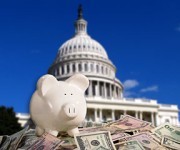It’s an article of faith that cap-and-trade will raise our energy costs, but it’s not necessarily true.
The ubiquity of this faith makes clear that the Smart People who write, talk, and vote about CO2 policy don’t really understand the issues. A quick discussion, and then some math to clarify.
There are two core problems with the theory that carbon pricing schemes will raise energy costs:
- We habitually confuse sector-specific wealth transfers with economy-wide pain; the two are not necessarily the same.
- Rather than admit our failure to imagine how the world would adapt to carbon pricing, we tend to assume stasis, thereby overstating the costs of compliance.
Discussion on both points follows.
Taxes vs. wealth transfers
First, a statement of the obvious: no one likes to lose money, and we’re all hypocrites, me included. Speeding tickets I have to pay are a drag on the economy and a diversion of police resources from more socially urgent activities; speeding tickets you pay are but a small drag on your income, offset by massive intangible social gains.
This love of money and hypocrisy is no less true for businesses. My reasoned argument against speeding tickets for Sean (or as I call them, “fun taxes”) is different only in degree from the coal company that argues CO2 regulation will be a tragedy for low-income rate payers.
So let’s agree to be more honest. If taxpayer X suddenly has a new $1,000 cost, it’s only a drag on the economy to the extent that the money disappears into non-productive activities. If the Fun Police give me a $200 ticket and then set my money on fire, it’s a clear economic drag. On the other hand, if those proceeds go to fund public safety measures that we all benefit from, then my personal economic pain is partially/wholly offset at a macro level. This is no less true with carbon regulation. If a coal company suddenly has a billion dollars worth of annual penalties it has to pay, but that billion dollars is used to bring an equivalent volume of clean energy forward, the wealth transfer isn’t necessarily a drag on the economy.
(I’m obviously over-simplifying a complicated story, but directionally, if the effect of a carbon regulatory regime is to replace high capital cost / low variable cost coal with an equivalent MWh production of high capital cost / zero variable cost renewables, then you could well end up with bankrupt coal companies but cheaper power and a stronger economy in the long run.)
This suggests that as we assess carbon policy, we shouldn’t be asking whether the price is high enough to impose meaningful penalties, but whether the result of the payment is a socially-benefical wealth transfer – as opposed to a socially-detrimental Money Fire. The basic problem with the vast majority of carbon regulatory models is that they fail to ask this question, even as they fall in love with the proceeds that CO2 auctions will send back to political bodies for redistribution. Political bodies historically have a certain preference for Money Fires.
Statics vs. dynamics
While it’s analytically easy to show possible scenarios wherein a CO2 regulatory model yields an economically-neutral wealth transfer, it’s impossible to guarantee that outcome, for the simple reason that none of us have a crystal ball. I can articulate plenty of scenarios wherein dirty MWh are displaced by clean ones, with the economic pain necessary to shut down the former is sufficient to incentivize construction of the latter. But I can’t guarantee that those possibilities will materialize. (As a friend at NREL once told me, “the great thing about writing laws is that you see behavior change immediately. The lousy thing about writing laws is that you don’t have any good way to predict how behaviors will change.”) Humans are too clever, and our behavior too dynamic, to allow accurate predictions.
That’s fine, except that when it comes to carbon regulation, we end up falling into one of two traps — either assuming omniscience (e.g., “This bill will change behavior as follows”) or stasis (e.g., “Assuming no change in behavior in response to this bill, economic impacts are as follows”). A classic example of this is in the “scoring” process that the Congressional Budget Office uses, wherein tax breaks are calculated based on their cost to the treasury. CBO analysis assumes that the only impact of the bill will be to reduce tax receipts — with no offset for increased demand for product and corresponding growth in personal and corporate income tax receipts. (Or, for that matter, any monetization of the social benefit sought by the tax break.)
The result is that all our predictions are wrong. Moreover, at least in my experience, the assumption of a static world is much more common, meaning our predictions are generally skewed in an unfavorable direction. Speeding tickets do make me drive slower. Likewise, putting a price on CO2 emissions will cause power plants and industrials to look for lower-carbon ways to stay in business. And yet we frame our analyses as if the only impact of a $20/ton CO2 price is a $20/ton increase in the price of power. It’s one thing to acknowledge our inability to predict the future, but something else entirely to presume that the human instinct not to lose money will suddenly go away once a carbon bill is passed.
Stay tuned!
Here’s the point: When you factor in both of these issues and run some pretty simple math, it becomes apparent that good carbon policy has the potential to be a massive wealth transfer that is damned near economically-invisible. Which in turn means that the hand-wringing and political horsetrading going on in DC right now as we debate CO2 policy is, while perhaps politically necessary, ultimately irrelevant. That’s a cause for some optimism.
Math coming in part II of this post.



